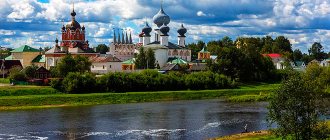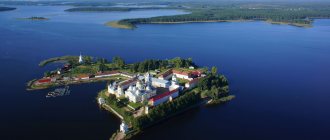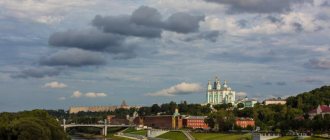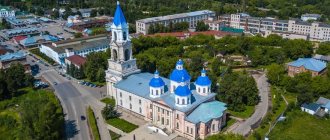City in Tver region, Russia
| Konakovo Konakovo | |
| Town[1] | |
| In the Donkhovka River in Konakovo. May 2008 | |
| Flag Coat of arms | |
| Location of Konakovo | |
| Konakovo Location of Konakovo Show map of Russia Konakovo Konakovo (Tver region) Show map of Tver region | |
| Coordinates: 56°42′N 36°45'E / 56.700°N W. 36.750°E / 56.700; 36.750Coordinates: 56 ° 42′ N 36°45'E / 56.700°N W. 36.750°E / 56.700; 36.750 | |
| A country | Russia |
| Federal subject | Tver region[1] |
| Administrative region | Konakovsky district[2] |
| urban village | Konakovo[2] |
| Based | 1806[3] |
| City status from | 1937[3] |
| Height | 130 m (430 ft) |
| population (2010 Census)[4] | |
| • General | 41,291 |
| • Evaluate (2018)[5] | 38,486 (−6.8%) |
| Administrative status | |
| • Capital from | Konakovo district[6], Konakovo town[2] |
| Municipal status | |
| • Municipal district | Konakovsky municipal district[7] |
| • Urban village | Urban settlement Konakovo[7] |
| • Capital from | Konakovo municipal district[8], urban-type settlement Konakovo[7] |
| Timezone | UTC + 3 (MSK [9]) |
| Postal code(s)[10] | 171250–171256 |
| Dial code(s) | +7 48242 |
| OKTMO I WOULD | 28630101001 |
| Web site | www.konakovo.v |
Konakovo
(Russian: Konakovo, IPA: [kənɐˈkovə]) is a town and administrative center of Konakovsky District in Tver Region, Russia, located on the right bank of the river. Ivankovskoye Reservoir (Volga River). Population: 41,291 (2010 Census);[4]42,335 (2002 Census);[11]42,522 (1989 Census).[12]
Geography
Konakovsky district is located in the southeast of the Tver region. It borders on the Kalininsky and Kimry districts of the Tver region, the Klinsky, Dmitrovsky and Taldomsky districts of the Moscow region. The area of the district is 2114 km².
Climatic conditions
District Resources
Mineral resources include sand, clay, and peat, which are of greatest importance. Large deposits of it are located in the vicinity of Redkino, Ozerkov, Reshetnikov. Peat is used as fertilizer, fuel and as bedding material in livestock farming.
Water resources
The Ivankovo Reservoir arose in connection with the construction of the Moscow Canal; it was formed as a result of the backwater of the Volga waters by the Ivankovo Dam.
In Konakovo, the Donkhovka River flows into the Volga, and on the left, near the village of Ustye, is the Soz River, flowing from Lake Velikoye.
Animal world
Transport
The Moscow-St. Petersburg railway (the main route of the Oktyabrskaya Railway) runs through the region, in its western part. On the territory of the district there are main railway stations - Chernichnaya, Zavidovo, Moscow Sea, Redkino, Mezhevo, as well as a railway bridge over the Ivankovskoye Reservoir. Also, the Reshetnikovo - Konakovo railway branch runs through the area (stations Puteprovodnaya, Konakovsky Mokh, Donkhovka, Konakovo State District Power Plant).
M10 motorway runs in the western part of the area
- to the northwest to Tver and St. Petersburg, to the southeast to Klin and Moscow. Roads depart from the highway in a western direction to Kozlovo and to Redkino - Izoplit, and in an eastern direction to Konakovo - Dubna - Kimry.
Economy
Konakovskaya GRES
B Konakovskaya GRES, a thermal power plant, is the largest enterprise in the Konakovo district. In 2008, it produced more than 60% of the district's GDP.[15]
Transport
In Konakovo there is a railway station, Konakovskaya State District Power Plant. It is connected to the St. Petersburg - Moscow Railway by a line that branches into Reshetnikovo. Connected by regular passenger commuter services to Moscow.
Konakovo has road connections from Kimry and to Zavidovo, where it has access to the M10 Highway, which runs between Moscow and St. Petersburg. There are also local roads with bus service.
KONAKOVO
Within the modern territory of the city there are several formerly separate settlements: Kuznetsovo, Shagarovo, Aleksandrovka, Klokovo, Skrylevo, Nikolskoye, Zaborye
and others. According to legend, the center of the future city was a blacksmith shop, which was founded by an enterprising man at the intersection of country roads. The settlement that arose at the forge was named Kuznetsova; the stream flowing nearby was also called “Kuznechny.” According to another version, the name was given by the name of one of the early owners of the village [1].
Sources first mention the village of Kuznetsovo in 1806. According to the “ Geometric special plan of the Tver province of Korchevsky district
" it is known that:
The faience factory, built in 1809 in the neighboring village of Domkino, was moved to Kuznetsovo in 1826-1828 and gave the main impetus to the further development of the city. Already in the first half of the 19th century, Kuznetsovo became widely known due to the largest production of household and artistic faience in Russia located there. Gradually, peasants flocking from surrounding villages in search of work began to settle around the factory buildings. The factory reached its greatest prosperity in 1840-1850, when its workshops employed up to 175 hired craftsmen and servants.
After the reform of 1861, things at the factory worsened, production was curtailed. Unable to withstand the competition, the owners in 1870 sold the factory to Matvey Sidorovich Kuznetsov, the owner of many porcelain and earthenware enterprises in Russia, “the king of Russian porcelain.” By 1890, the production of dishes from semi-faience, majolica, and porcelain had also been mastered, and the products became more widespread. After the construction of the church in 1891, Kuznetsovo became a village.
Statistics
Konakovo is a city in the Tver region, located at the mouth of the Donkhovka River, on the banks of the Ivankovo Reservoir. The main enterprises, and perhaps the main attractions of the city, are the Konakovo State District Power Plant and the porcelain and earthenware factory
.
It’s worth staying here for a few days, renting apartments for daily rent in Konakovo, and exploring the local beauty. The portal Sutochno.ru will tell you how rich the city is.
Earthenware factory
A unique monument of industrial architecture
Today they represent the old buildings of a faience factory. They have become a kind of “calling card” of the city and organically fit into its current landscape, giving a special flavor to the former “capital of faience”. Yes, that’s what Konakovo was called in the past.
Church of the Nativity of the Virgin Mary
Church of the Nativity of the Mother of God - a unique architectural monument of the 14th century
, located in Konakovsky district.
This is not only the oldest building in the Tver region, but also one of the oldest churches in Russia
. To see this famous church, you will have to go to the village of Gorodnya, located nearby. The church also became famous for the fact that ancient frescoes dating back to the 15th century were discovered in its underground temple.
Karacharovo village
A very interesting place is the village of Karacharovo, located within an urban settlement. Many ancient buildings and attractions have been preserved here. Most of the buildings date back to the second half of the 19th century. At that time, the village was owned by the famous educator and painter, Prince Gagarin. In the village it is worth seeing the landowner's house, the Church of Peter and Paul, as well as an ancient park, which was laid out in the likeness of London's Hyde Park. There are also healing mineral springs in Karacharovo
, where the boarding house now operates. However, if you wish, you can also rent an apartment for a day in Konakovo.
Monument to Porfiry Konakov
The monument is located at the railway station. As for Porfiry Konakov himself, he was a famous freedom fighter and a tireless revolutionary
. In 1906 he organized a sailor riot in Kronstadt, for which he was subsequently shot. The city was renamed in his honor in 1929.
Ruins of the city of Korcheva
A glorious ancient city with beautiful buildings and golden-domed churches, Korchev was flooded at one time during the creation of the Ivankovo reservoir. All that remains today of the majestic city is only an ancient cemetery, a church near it and the house of the Rozhdestvensky merchants, the only surviving stone structure. This is how the Sutochno.ru portal saw the extraordinary city of Konakovo. We wish you a pleasant holiday!
Tags: Attractions, What to see
Religion
An Orthodox church was opened in Kuznetsovo in 1891, built at the expense of the factory owner. The temple was destroyed under Soviet rule. After the destruction of the Alexander Nevsky Temple in 1961, there was no large church in the city. At the beginning of the 21st century, Konakovo was the center of the Konakovo deanery of the Tver diocese, construction of a large-scale temple of the Forty Martyrs of Sebaste was underway.
In 1915, an Old Believer church was opened, for which two faience and enamel iconostases were specially made. It was destroyed under Soviet rule.
Temples of the city
Temples of the Deanery
Source
Konakovsky municipal district of Tver region
The places that are now part of the territory of the Konakovsky district have been historically known since the 12th century, when they were part of the Kyiv state, within which the Vladimir-Suzdal principality was located. In the middle of the 13th century, the Tver Principality emerged from the latter. At the end of the 18th century, during the reforms of Catherine II, the modern territory of the Konakovsky district became part of the Korchevsky district of the Tver province (1781).
According to information for 1863, the number of inhabitants of Korcheva was 3,317 people. In Korchev there were 410 courtyards, of which 26 had stone houses, three stone churches, forty-one shops, three hotels, two taverns, four inns, two schools, and a hospital. In 1861, there were several small industrial establishments in the city: a molasses factory, a brewery, two gingerbread factories and two brick factories. According to the 1897 census, there were 2,400 inhabitants in Korchev, in 1913 - 2,518, in 1923 - 2,353 inhabitants.
In 1922, Korcheva became a city without a district and was assigned to the Kimry district. In 1927, the Konakovsky district was formed, which included most of the former Korchevsky district, including the city of Korcheva. In 1932, a decision was made to build the Moscow-Volga canal, as a result of which the city fell into the flood zone. By a resolution of the Presidium of the All-Russian Central Executive Committee of March 2, 1937, the center of the Konakovsky district was moved from Korcheva to Konakovo, which at the same time received the status of a city. By the same decree, Korcheva was officially excluded from the lists of cities.
At the moment, in the unflooded area there is a cemetery with overgrown remains of the foundation of the Kazan Church and one single stone building - the house of the Rozhdestvensky merchants - a typical representative of the architectural style of urban development of the early 20th century.
The economic role of the region has changed since the early 60s, when the construction of Europe's largest thermal power plant, the Konakovo State District Power Plant, began. A whole new city has grown up in Konakovo - a settlement of power engineers on the right bank of the Volga. Now this is a new part of the city, where the main institutions of the city are located and most of the population lives. In addition, enterprises were built - ZSK, ZMI, bakery, ZKPD and others. New schools, kindergartens, hospitals, shops, and cultural facilities were built.
Our region is of significant importance and plays a significant role in the history of the Tver Upper Volga region and its modern life. The ancient Korchev land has always been famous for its patriots who sought to preserve its history and culture and increase its spiritual values. Favorable geographical location, rich nature, production, intellectual and cultural potential create favorable conditions for the further development of the Konakovo region.
Source
Story
Konakovo faience factory
Konakovo was founded in 1806 as a village
from
Kuznetsovo
(Kuznetsovo).[3]
The name comes from the surname Kuznetsov, who was one of the first owners. The village
did not do well, and by the 1820s it was almost deserted.[3] In 1826–1828 The earthenware factory was moved there from the village of Domkino, about 30 km east of Kuznetsovo.[3] The plant was built by the merchant Auerbach in Domkino on land owned by a local landowner, and by 1829 the lease had expired and was not renewed.[3] In 1826, Auerbach bought all the lands in Kuznetsov and its environs.[3] In 1870, the factory was bought by an industrialist. Matvey Kuznetsov (no relation to Kuznetsov, who gave the village its name) and became known as the Kuznetsov Faience Factory.[3] After 1918, the factory was nationalized, and art production became one of its specializations.[3] To this end, he established collaborations with many famous Russian artists of the time.[3]
At that time, Kuznetsovo was part of the Korchevskaya district in the Tver province.[13] On May 30, 1922, Korchevsky district was abolished and annexed to Kimry district.[14] On July 14, 1925, Kuznetsovo was granted an urban settlement status.[3]
On July 12, 1929, the Tver province was abolished, and the territory was transferred to the Moscow region.[14] The counties and the Kuznetsovsky district with the administrative center in the city of Korcheva were abolished, and the Kimry district was created from the Moscow region.[14] On July 23, 1930, the districts were abolished, and the districts were directly subordinated to the region.[14] On February 26, 1930, Kuznetsovo was renamed Konakovo, and the Kuznetsovsky district - Konakovsky,[14] in memory of Porfiry Konakov, a participant in the 1905 Revolution.[3] On January 29, 1935, the Kalinin region was created, to which the Konakovsky district was transferred.[14] In 1937, when the Ivankovskoye Reservoir was filled, Korcheva sank under water.[13] The administrative center of the district was transferred to Konakovo, which was given city status on March 2, 1937.[13] On February 13, 1963, during Nikita Khrushchev's failed administrative reform, the Konakovsky district was annexed to the Kalininsky district, but was recreated on January 12, 1965.[14] In 1990, the Kalinin region was renamed the Tver region.[ citation needed
]







